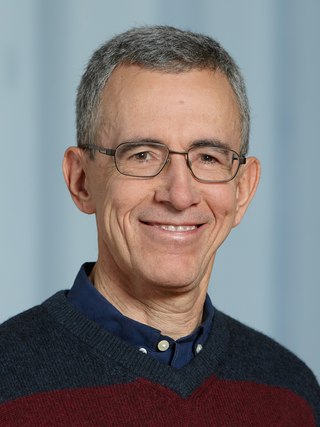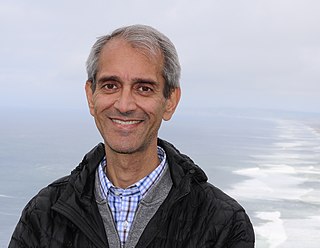Related Research Articles

The New York University Tandon School of Engineering is the engineering and applied sciences school of New York University. Tandon is the second oldest private engineering and technology school in the United States.
Terrence Joseph Sejnowski is the Francis Crick Professor at the Salk Institute for Biological Studies where he directs the Computational Neurobiology Laboratory and is the director of the Crick-Jacobs center for theoretical and computational biology. He has performed pioneering research in neural networks and computational neuroscience.
Irving Stoy Reed was an American mathematician and engineer. He is best known for co-inventing a class of algebraic error-correcting and error-detecting codes known as Reed–Solomon codes in collaboration with Gustave Solomon. He also co-invented the Reed–Muller code.
Rahul Sarpeshkar is the Thomas E. Kurtz Professor and a professor of engineering, professor of physics, professor of microbiology & immunology, and professor of molecular and systems biology at Dartmouth. Sarpeshkar, whose interdisciplinary work is in bioengineering, electrical engineering, quantum physics, and biophysics, is the inaugural chair of the William H. Neukom cluster of computational science, which focuses on analog, quantum, and biological computation. The clusters, designed by faculty from across the institution to address major global challenges, are part of President Philip Hanlon's vision for strengthening academic excellence at Dartmouth. Prior to Dartmouth, Sarpeshkar was a tenured professor at the Massachusetts Institute of Technology and led the Analog Circuits and Biological Systems Group. He is now also a visiting scientist at MIT's Research Laboratory of Electronics.

Symbol Technologies is an American manufacturer and supplier of mobile data capture and delivery equipment. The company specializes in barcode scanners, mobile computers, RFID systems and Wireless LAN infrastructure. In 2014, Symbol Technologies became a subsidiary of Zebra Technologies, and is headquartered in Holtsville, New York, on Long Island.

Tomo Razmilovic is a Croatian-born Swedish businessman, formerly the CEO of Long Island, New York-based Symbol Technologies. He is the suspected mastermind of a massive accounting fraud that ultimately cost the company its independence. Currently, the United States Government considers him a fugitive, with the United States Postal Inspection Service offering a $100,000 reward for information leading to his arrest and conviction.
John Yen is Professor of Data Science and Professor-in-Charge of Data Science in the College of Information Sciences and Technology at Pennsylvania State University. He currently leads the Laboratory of AI for Cyber Security at Penn State. He was the founder and a former Director of the Cancer Informatics Initiative there.
Meredith Charles "Flash" Gourdine was an American athlete, engineer and physicist. His nickname, "Flash" Gourdine, is a reference to comic strip character Flash Gordon.
Dr. Lawrence Jerome Fogel was a pioneer in evolutionary computation and human factors analysis. He is known as the inventor of active noise cancellation and the father of evolutionary programming. His scientific career spanned nearly six decades and included electrical engineering, aerospace engineering, communication theory, human factors research, information processing, cybernetics, biotechnology, artificial intelligence, and computer science.

Ataç İmamoğlu is a Turkish-Swiss physicist working on quantum optics and quantum computation. His academic interests are quantum optics, semiconductor physics, and nonlinear optics.
Dimitris Anastassiou is an electrical engineer and Charles Batchelor Professor of Electrical Engineering in the Columbia University School of Engineering. Anastassiou's earlier work focuses primarily on signal and information processing and reverse engineering. His more recent work involves interdisciplinary research, specifically in systems biology, with investigators at Columbia University Medical Center. Anastassiou is Fellow of the IEEE for contributions to video technology, developing high-performance digital image and video coding techniques . He is also a Fellow of the National Academy of Inventors and recipient of both the National Science Foundation Presidential Young Investigator Award and the IBM Outstanding Innovation Award.
Kwabena Adu Boahen is a Ghanaian-born Professor of Bioengineering and Electrical Engineering at Stanford University. He previously taught at the University of Pennsylvania.

Pietro Perona is an Italian-American educator and computer scientist. He is the Allan E. Puckett Professor of Electrical Engineering and Computation and Neural Systems at the California Institute of Technology and director of the National Science Foundation Engineering Research Center in Neuromorphic Systems Engineering. He is known for his research in computer vision and is the director of the Caltech Computational Vision Group.

Shrikanth Narayanan is an Indian-American Professor at the University of Southern California. He is an interdisciplinary engineer–scientist with a focus on human-centered signal processing and machine intelligence with speech and spoken language processing at its core. A prolific award-winning researcher, educator, and inventor, with hundreds of publications and a number of acclaimed patents to his credit, he has pioneered several research areas including in computational speech science, speech and human language technologies, audio, music and multimedia engineering, human sensing and imaging technologies, emotions research and affective computing, behavioral signal processing, and computational media intelligence. His technical contributions cover a range of applications including in defense, security, health, education, media, and the arts. His contributions continue to impact numerous domains including in human health, national defense/intelligence, and the media arts including in using technologies that facilitate awareness and support of diversity and inclusion. His award-winning patents have contributed to the proliferation of speech technologies on the cloud and on mobile devices and in enabling novel emotion-aware artificial intelligence technologies.
Eero Simoncelli is an American computational neuroscientist and Silver Professor at New York University. He was a Howard Hughes Medical Institute Investigator from 2000 to 2020. In 2020, he became the inaugural director of the Center for Computational Neuroscience at the Flatiron Institute of the Simons Foundation.

Krishna Vaughn Shenoy (1968–2023) was an American neuroscientist and neuroengineer at Stanford University. Shenoy was the Hong Seh and Vivian W. M. Lim Professor in the Stanford University School of Engineering. He focused on neuroscience topics, including neurotechnology such as brain-computer interfaces. On 21 January 2023, he died after a long battle with pancreatic cancer. According to Google Scholar, he amassed an h-index of 79.
Surya Ganguli is a university professor at Stanford University and a visiting research professor at Google. Ganguli is primarily known for his work on neural networks and deep learning, although he has also published papers on theoretical physics. He presently runs the Neural Dynamics and Computation Lab at Stanford, where he aims to reverse engineer how networks of neurons and synapses cooperate across multiple scales of space and time to facilitate sensory perception, motor control, memory, and other cognitive functions. He is also known for being a prolific public speaker and lecturer, having been invited to give over 200 talks at various universities, institutes, workshops, conferences, and symposiums since 2005.
Ralph Etienne-Cummings is an academic in the field of electrical engineering. He is a professor of Electrical & Computer Engineering at Johns Hopkins University.
References
- ↑ Funding Universe history of Symbol Technologies
- ↑ http://www.theswartzfoundation.org/swartz-bio.asp Bio
- 1 2 Feder, Barnaby J. (8 July 2003). "Two Symbol Officials Quit Amid Fraud Investigations". New York Times. Retrieved 25 May 2014.
- ↑ "Symbol Technologies Agrees to Settle SEC Enforcement Action Charging the Company with Accounting Fraud". Securities and Exchange Commission. Retrieved 25 May 2014.
- ↑ "IEEE Ernst Weber Engineering Leadership Recognition Recipients" (PDF). IEEE. Retrieved November 20, 2010.